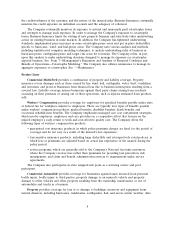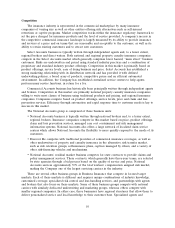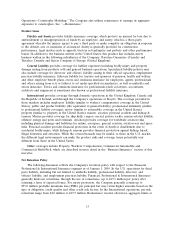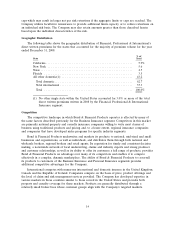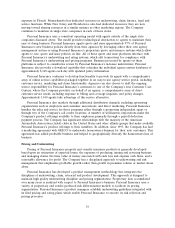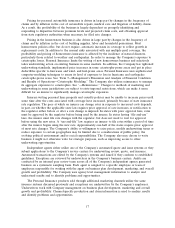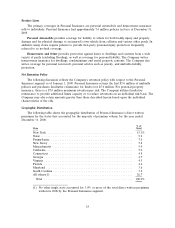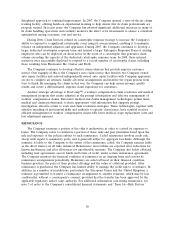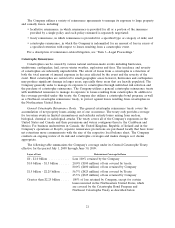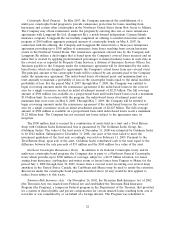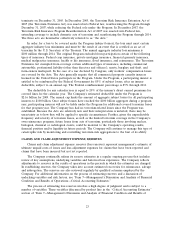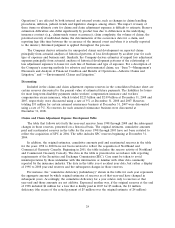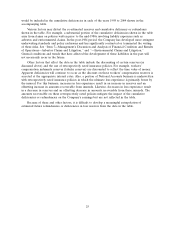Travelers 2008 Annual Report Download - page 29
Download and view the complete annual report
Please find page 29 of the 2008 Travelers annual report below. You can navigate through the pages in the report by either clicking on the pages listed below, or by using the keyword search tool below to find specific information within the annual report.Pricing for personal automobile insurance is driven in large part by changes in the frequency of
claims and by inflation in the cost of automobile repairs, medical care and litigation of liability claims.
As a result, the profitability of the business is largely dependent on promptly identifying and
responding to disparities between premium levels and projected claim costs, and obtaining approval
from state regulatory authorities when necessary for filed rate changes.
Pricing in the homeowners business is also driven in large part by changes in the frequency of
claims and by inflation in the cost of building supplies, labor and household possessions. Most
homeowners policies offer, but do not require, automatic increases in coverage to reflect growth in
replacement costs. In addition to the normal risks associated with any multiple peril coverage, the
profitability and pricing of homeowners insurance is affected by the incidence of natural disasters,
particularly those related to weather and earthquakes. In order to manage the Company’s exposure to
catastrophe losses, Personal Insurance limits the writing of new homeowners business and selectively
takes underwriting action on existing business in some markets. In addition, the Company has tightened
underwriting standards, implemented price increases in some catastrophe-prone areas and put in place
deductibles specific to hurricane and wind- and hail-prone areas. Personal Insurance uses sophisticated
computer-modeling techniques to assess its level of exposure to loss in hurricane and earthquake
catastrophe-prone areas. See ‘‘Item 7—Management’s Discussion and Analysis of Financial Condition
and Results of Operations—Catastrophe Modeling.’’ The Company also utilizes reinsurance to manage
its aggregate exposures to catastrophes. See ‘‘—Reinsurance.’’ Changes to methods of marketing and
underwriting in some jurisdictions are subject to state-imposed restrictions, which can make it more
difficult for an insurer to significantly manage catastrophe exposures.
Insurers writing personal lines property and casualty policies may be unable to increase prices until
some time after the costs associated with coverage have increased, primarily because of state insurance
rate regulation. The pace at which an insurer can change rates in response to increased costs depends,
in part, on whether the applicable state law requires prior approval of rate increases or notification to
the regulator either before or after a rate change is imposed. In states with prior approval laws, rates
must be approved by the regulator before being used by the insurer. In states having ‘‘file-and-use’’
laws, the insurer must file rate changes with the regulator, but does not need to wait for approval
before using the new rates. A ‘‘use-and-file’’ law requires an insurer to file rates within a period of time
after the insurer begins using the new rate. Approximately one-half of the states require prior approval
of most rate changes. The Company’s ability or willingness to raise prices, modify underwriting terms or
reduce exposure to certain geographies may be limited due to considerations of public policy, the
evolving political environment and/or social responsibilities. The Company also may choose to write
business it might not otherwise write for strategic purposes, such as improving access to other
underwriting opportunities.
Independent agents either utilize one of the Company’s automated quote and issue systems or they
submit applications to the Company’s service centers for underwriting review, quote, and issuance.
Automated transactions are edited by the Company’s systems and issued if they conform to established
guidelines. Exceptions are reviewed by underwriters in the Company’s business centers. Audits are
conducted by an internal peer review team across all of the Company’s independent agency generated
business on a systematic sampling basis. Each agent is assigned to a specific employee or team of
employees responsible for working with the agent on business plan development, marketing, and overall
growth and profitability. The Company uses agency level management information to analyze and
understand results and to identify problems and opportunities.
The Personal Insurance products sold through additional marketing channels utilize the same
issuance systems discussed previously and exceptions are underwritten by the Company’s employees.
Underwriters work with Company management on business plan development, marketing and overall
growth and profitability. Channel-specific production and claim information is used to analyze results
and identify problems and opportunities.
17



